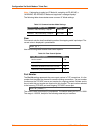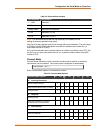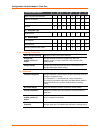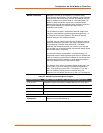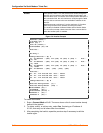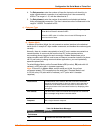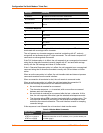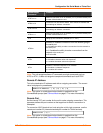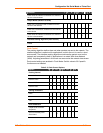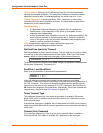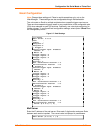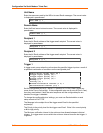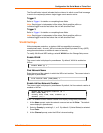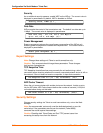
Configuration Via Serial Mode or Telnet Port
5-14 WiPort™ User Guide
DisConnMode
Disconnect Mode (DisConnMode) determines the conditions under which the unit will
cause a network connection to terminate. The current value is displayed in
parentheses.
DisConnMode ( 0) ? _
In DisConnMode, modem_control_in either drops the connection or is ignored. The
following table displays the available input options:
Table 5-10. Disconnect Mode Options
Disconnect Mode Option 7 6 5 4 3 2 1 0
Disconnect with
modem_control_in drop
(6)
1
Ignore modem_control_in 0
Telnet mode and terminal type
setup
(1)
1
Channel (port) password
(2)
1
Hard disconnect
(3)
0
Disable hard disconnect 1
State LED off with connection
(4)
1
Disconnect with EOT (^D)
(5)
1
(1) The WiPort sends the "Terminal Type" upon an outgoing connection.
(2) A password is required for a connection to the serial port from the network.
(3) The TCP connection closes even if the remote site does not acknowledge the disconnection.
(4) When there is a network connection to or from the serial port, the state LED turns off instead of blinking.
(5) When Ctrl D or Hex 04 is detected, the connection is dropped. Both Telnet mode and Disconnect with
EOT must be enabled for Disconnect with EOT to function properly. Ctrl D is only detected going from the
serial port to the network.
(6) When modem_control_in transitions from a high state to a low state, the network connection to or from the
serial port drops.
Flush Mode
The FlushMode (buffer flushing) parameter controls line handling and network buffers
with connection startup and disconnect.
FlushMode ( 0) ? _
Select between two different packing algorithms (the current configuration is
displayed within the parentheses). Available Flush Mode options are:
Table 5-11. Flush Mode Options
Function 7 6 5 4 3 2 1 0
Input Buffer (Serial to Network)
Clear with a connection that is initiated from the
device to the network
1
Clear with a connection initiated from the network
to the device
1



